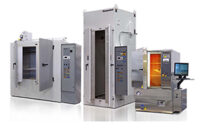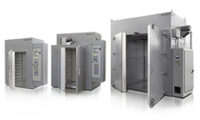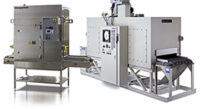Industrial process ovens are critical for many production processes. And selecting the right industrial oven for a production application can be confusing.
One critical consideration when choosing an industrial oven is the unit’s chamber size. Selecting the right chamber size is critical whether you’re buying a standard or a custom process oven.
Too small a chamber space inhibits the oven from doing its job. Too large a chamber space wastes energy and increases costs. Several factors determine how large a chamber you’ll need, including the type of oven you choose and the application itself. Other factors influencing chamber size include special processing needs, interior construction, and load size.
Define Your Application First
Defining your application is the first step in selecting an oven. It’s also a critical step in determining chamber size. Different types of ovens require different size chambers. The first step in this process, then, entails nailing down the oven’s function.
You’ll also need to nail down the environment the oven will be working in. Plus, you’ll need to nail down whether you’ll need a batch oven or a continuous oven. Both oven types work well in the right situations.
Batch ovens are ideal where load size or production volume varies a lot. They’re also ideal for applications where the ability to handle a high degree of flexibility in variables, such as temperature or soak times, exists. Batch ovens can process a broad range of heat treatment processes.
Continuous ovens, on the other hand, are ideal for applications where you’re processing a large number of product pieces. They ensure consistent thermal processing times for each part in high-volume applications.
Types of Industrial Oven Chamber Sizes
Industrial ovens are available in four-chamber size categories:
Lab or benchtop ovens are small and convenient. Ideal for use in a laboratory test and development that involve small-batch loads. These ovens range in chamber size from 1 cubic foot to 27 cubic feet (28 to 764 liters). Because of their small, convenient chamber sizes, these ovens work well in laboratory test and development applications, as well as production applications that require small batch loads. In addition, these ovens can often be stacked to save on floor space.

Cabinet (or reach-in) ovens are designed for easy loading and unloading of parts, components, or products. Cabinet ovens are floor-mounted and very efficient in terms of footprint. They typically range in size from 4 feet to 35 cubic feet. This size is referred to as a reach-in oven because they are ergonomically designed for easy loading and unloading.

Walk-in and truck-in ovens are well suited for loading by fork truck or manually. Typically, truck-in oven chambers range from 52 to 210 cubic feet, and larger walk-in ovens start at 360 cubic feet and larger. Large batch ovens can accommodate a wide variety of specific product/process needs. Walk-in ovens are ideal for truckload type applications or for large, heavy, or hard to handle parts.

Conveyor ovens are used for continuous processing. The size of the chamber is limited to the width and parts production per hour is determined by the conveyor belt speed and how many parts per linear foot. End gates are adjustable to accommodate various product heights while minimizing heat loss for low-profile products. It is important to determine how your products will fit on the belt. Products should be spaced on the conveyor to allow for optimal uniformity.

Additional Industrial Oven Considerations
The considerations below will help you select the right industrial oven with the right chamber size for your applications. If you’re still confused about choosing the right chamber size, you can contact an industry expert. Or, you can consult a highly regarded oven manufacturer, like Despatch, which has a reputation for providing its customers with superior industrial process ovens.
Load size – The number of products, the size of the parts, the number of batches, and the need for multiple heating/cooling zones are factors affecting chamber size. So is load size. If the application’s load size or production volumes vary substantially, batch processing works well in this situation.
If your application involves a large quantify of the same type of product or parts, then continuous operation is ideal. Continuous ovens ensure consistent thermal processing times for all parts in high-volume situations.
Airflow management system – Airflow management within a chamber is critical consideration when it comes to process quality. You want to choose the correct airflow for your product needs. In general, a forced convection oven with recirculating airflow provides the best heat distribution within a chamber.
It also speeds the time-to-temperature and heat transfer to parts. Meanwhile, temperature uniformity and performance depend on a fan design to direct air to all chamber areas. How the product is loaded determines the type of airflow need to provide uniform heat distribution to all of the load’s parts.
Interior chamber construction – Process-specific factors usually determine interior chamber construction. Some things to keep in mind with interior chamber construction. Stainless steel provides corrosion resistance and cleans easily. Aluminized and mild steel are less expensive but offer less protection against corrosion, rust, and contamination.
Shelves should feature a sturdy, non-tip design and allow for proper airflow and easy product loading/unloading. Also, surface temperature specifications may require special construction techniques, while load support design depends on the load’s type and weight.
Special processing needs – Your application may require a clean process oven to prevent particulate contamination of sensitive products. For example, if you’re processing a combustible product or removing combustible vapors from a product, you’ll need a Class A oven that meets NFPA 86 requirements.
In addition, class A ovens must have an explosion-relief area. The required explosion-relief area must be equivalent to at least one-fifteenth of the oven’s interior volume or a 15:1 volume-to-venting-area ratio.
For example, an oven with a total volume of 45 ft 3 needs to have at least 3 ft 2 of relief vent area. Class A ovens must also have positively forced ventilation sized to accommodate the amount of combustible product in the maximum oven load. Class A ovens must have a purge period before the heat source can be energized. This purge period must be long enough to get at least four air changes of interior volume.
Some processes requiring inert atmosphere ovens, which provide nitrogen or argon gas, or to prevent product oxidation at elevated temperatures, you’ll need special features. In these situations, inert gas is injected into the chamber, pressuring the chamber and replacing the oxygen. Critical features in these chambers include high integrity welds and special motor seals.
Chamber Size: One Critical Question
Manufacturers face numerous challenges in today’s post-pandemic world. A gap in skilled labor, trade war effects, the increasing use of the IoT, timely product delivery, and supply chain visibility are just some of those challenges. One thing, however, remains the same going forward. Industrial process ovens will remain critical equipment in a wide variety of production processes, including food production, electronics, chemical processing, ceramics, and coating processing.
Choosing the right chamber size is critical when buying an industrial oven. That can be a challenge. You want a chamber that fits your specific needs. Too small a chamber space inhibits product performance and quality. Too large a chamber space wastes energy. While several factors determine chamber size, it ultimately comes down to answering one critical question: Does the chamber have sufficient heating capacity to bring the product to the desired temperature within the specified cycle time?
If you still have questions about choosing the right chamber size for your industrial oven, you can check out our field guide to buying an industrial oven. Or, you can call our skilled customer service team to assist you. Please call 952-469-8240.






